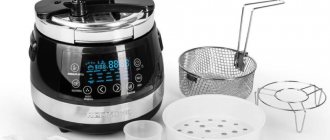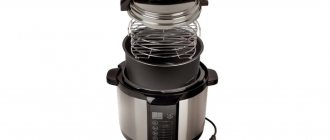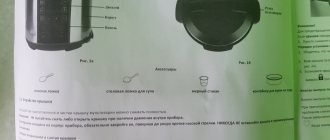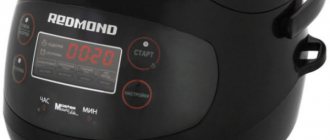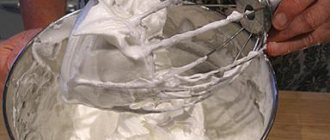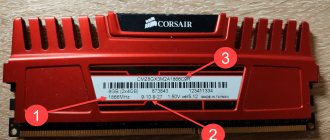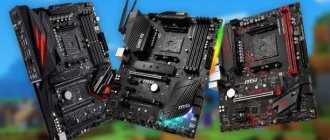Girls, there are only a few days left before the start of the marathon, so we are starting to actively dive into the secrets of multi-cookers.
If you haven't signed up yet, you can do so here >>>
Ready?)
We start on August 24 , and while we’re getting ready, I’ll talk about what a multicooker should be like and the mistakes when choosing it.
Sit back, pour yourself some aromatic tea, there will be a lot of useful information! 
A little technical wisdom.
A multicooker is a magical saucepan with a non-stick coating, a tight-fitting lid and a heating element at the bottom.
And what makes it magical are the built-in programs, in which all you have to do is load the ingredients for the dish, select the desired program, and the multicooker will set the temperature and cooking time itself.
Therefore, the question WHY you need a multicooker disappears by itself: tasty, fast, healthy, without the participation of the hostess. Who wouldn't want such a helper in their kitchen?)
But HOW to choose the one so that it is easy to operate, and the instructions are not written in alien language, and the cooking process is really simplified, and does not add headaches?
Types of multicookers
Without exception, all brands of household appliances have this unit in their product line. Depending on the manufacturing company, there is a difference in functionality, but if we divide it into types, then there are three of them:
- standard - using only temperature and natural atmospheric pressure when cooking (without pressurization);
- instant cooking, in which, in addition to temperature, strong pressure inside the bowl is applied to cook food (it is pumped automatically);
- induction, where an induction coil is used instead of a conventional heater.
In the latter, the container heats up at lightning speed, under the influence of a magnetic field. Different types of multicookers heat up at different rates.
IMPORTANT! The heating speed does not affect the speed of cooking.
Principle of operation
A multifunctional electrical appliance consists of a housing, a bowl, a lid, a heating element, temperature and control sensors, a control unit and program selection, and a moisture collector. At the bottom there is a heating element, which evenly heats the metal cooking container.
Control panel programs have built-in modes and operating duration. Some modes cyclically heat the bowl of food: for the first few minutes, the contents are heated at maximum temperature, then reduced. Therefore, the cooking time is reduced and the possibility of boiling over is minimal. To decide whether it is possible to open the multicooker during cooking, you need to know the cooking period and carefully lift the lid.
It is worth noting that the bowl has high sides, which heat up after the program starts. Therefore, you need to carefully place food into a heated multicooker, without touching the wall of the dish.
Basic operating rules
Different models of multicookers have general rules for use:
- Before turning on the device for the first time, you should carefully study the instructions, pay attention to the modes and their features;
- The initial use of the device should be a test and aimed at cleaning the multicooker from foreign odors - to do this, just boil water in it, then thoroughly rinse the valve and the inner pan;
- during subsequent use, you must be careful with the coating of the pan - it has a non-stick layer, so you cannot use appliances that could damage it when cooking;
- When washing, use only liquid detergents and a soft sponge.
REFERENCE! The device has a reservoir on the side of the body to collect condensate. It must be removed and washed after each cooking.
Popular models
Many manufacturers of household appliances produce multicookers. The most well-known names are: “Redmond”, “Polaris”, “Bosch”, “Mulinex”, “Tefal”, “Panasonic”, “Scarlet” and a number of others. Buyers pay attention to the presence of a number of useful characteristics:
- possibility of delayed start;
- built-in functions;
- non-stick coating of the bowl;
- manual selection of temperatures and cooking times;
- volume of container for storing products.
The following types of devices exist on the market:
- multicooker;
- pressure cooker;
- electric grill;
- rice cooker;
- sous vide
The first two types are the most popular.
Is it possible to open the multicooker lid during cooking?
There is no clear recommendation whether it is possible to keep the lid closed when using the device or whether it is permissible to open it. A lot depends on the dish that is being prepared. Thus, many people do not close the lid at all in the “Frying” mode, but it is not recommended to open the lid of the pressure cooker when preparing pilaf - the temperature balance is disturbed.
Therefore, in principle, the lid is not opened even in the “Baking” mode, supposedly this affects the “behavior” of the dough and worsens the taste of the finished baked goods. When preparing liquid dishes in the “Cooking” mode or stewing vegetables, whether the appliance is closed or closed does not play a big role. Considering that opening the lid during cooking does not in any way impair the technical qualities and does not affect the service life, the answer to this question is not critical. Each user does as he sees fit.
Safe frying
In addition to stewing, boiling, steaming, in many electrical appliances you can select the “frying” or “deep-frying” mode. This mode has the highest heating temperature for the bowl. When adding oil, splashes and splashes may occur.
Is it possible to fry in an open slow cooker? The walls of the bowl are high, so the oil splashes less when the lid is open. But you should be careful when turning and adding food items for cooking. You can get burned from hot oil or from the walls of a heated bowl.
Useful tips
The rubber rim on the inside and the sealed lid on the outside are a thermos. If warm milk with the addition of starter is left inside the multicooker until the morning, you will get amazing-tasting kefir. When using baked milk with sourdough, you will get fermented baked milk with a rich taste. Using the “Stew” mode, you can boil milk in an hour and a half, without it “running away”. And if you leave the milk in the same mode for another six hours, you will get baked milk. The “Baking” mode is perfect for frying meat and fish with a golden brown crust.
IMPORTANT! The multicooker has a keep warm function. The convenience is that the dish is first prepared and the mode automatically switches to heat maintenance. This feature can be used to prepare breakfast in the evening or get a hot meal in the morning - alternatively, porridge.
The “Heating” mode will help you get tasty, healthy and environmentally friendly homemade yogurt in just twelve hours. When using the "Bake" mode, there are often cases when the cake sticks or burns to the inner bowl. In the first case, greasing the walls with a fatty product (butter, margarine) and placing baking paper on the bottom will help solve the problem. In the second case, the cause is an incorrectly selected time mode. It must be set manually. Also, both of these issues can be solved radically - purchase a model with a ceramic bowl or buy it separately. This kitchen unit can also be used in such an unusual way as an air humidifier. To do this, you need to open the device and move it to the desired room and then turn on the water to boil.
Subscribe to our Social networks
Steaming
To prepare dishes in this way, water is poured into the bowl, which boils and evaporates. Products that need to be steamed for a specified period of time are laid out on a special plastic grill.
Is it possible to open the multicooker during steam cooking? When choosing this mode, you must carefully open the bowl, protecting your hand skin from the steam.
It is impossible to definitively answer the question whether it is possible to open the multicooker during cooking or cook with the lid open. The device is designed for minimal human intervention in the process. This makes it good and convenient.
However, sometimes it is necessary to open an electrical appliance. At such moments, it is advisable to know the cooking mode. During frying, splashes and splashes of hot oil may occur. When steaming, hot fumes collect under the lid and escape with minimal depressurization.
Particular care should be taken when lifting the lid in multi-pressure cookers. Before opening, it is necessary to open the valve and release the accumulated steam. Otherwise, the risk of getting burned increases.
Before you start using the multicooker, you should read the “precautionary measures” section of the instruction manual. Each electrical appliance has operating features that should be taken into account during use for personal safety. After this, it will become clear whether it is possible to open the multicooker while cooking.
How to determine which element is faulty
It's time to test the thermal fuses to see if any need to be replaced. It also happens that all these elements need to be changed. You can check the condition of the part with a tester.
Do-it-yourself repair of the Polaris multicooker is quite simple in this regard. After all, you don’t even have to remove the thermal fuses to check them.
The next sensor is located in the lid, but it is undesirable to open it without being sure that the reason for the breakdown of the multicooker lies there. You can check the sensor by measuring the resistance in its wiring and at the same time increasing the temperature of the cover.
If no change occurs, then the sensor has indeed failed and should be replaced
Then it’s time to unscrew the lid, but you need to do this very carefully so as not to damage anything inside.
Typical errors and their characteristics
Each multicooker model has a user manual, which shows possible causes of errors and the inability to continue operation.
In some cases, the same code may indicate several malfunctions at once, so this factor must be taken into account.
Before you take your multicooker in for repair, you can try to find out what exactly is the reason. The following tip will help with this.
| Error code | Possible reasons |
| E1 | Moisture gets on the heating element or it burns out |
| E2 | Broken power cable or faulty top heat sensor |
| E3 | Possible moisture on the heating shade or the lid is not tightly closed |
| E4 | Board fault or clogged pressure sensor |
| E5 | Automatic shutdown of the multicooker due to overheating. Prevents premature wear of the ten. |
Expert opinion
Torsunov Pavel Maksimovich
In some cases, errors cannot be resolved on your own or their code is displayed incorrectly. Then you cannot do without qualified repair specialists. Initially, you need to understand what could trigger the appearance of a particular code on the display and try to eliminate this reason as far as possible.
E1
This error occurs in three cases:
- There is a hole in the bowl through which the liquid enters the heating element.
- Foreign objects and food residues get on the heating element, which causes combustion processes.
- Malfunction of the ten itself and its burnout.
To make sure the heater is working properly, it is recommended to unplug the multicooker, carefully open the lid and remove the bowl. Next, plug the plug into the outlet and control the heating process. Its absence provides the answer to why the E1 code appeared.
E2
This problem most often occurs due to a break in certain parts of the cable, the connection of which to the multicooker does not cause it to turn on. You can check this reason by connecting an alternative cable (you can ask your friends or neighbors). If the device works when it is connected, then the reason has been found.
Sometimes E2 appears when the thermal sensor located at the top is shorted. It is recommended to open the lid, carefully remove the bowl and observe the operation of the heating element when the plug is plugged in. If the error appears again when closing the lid, then the malfunction has been found.
E3
The most common mistake that occurs is when the lid is not tightly closed. In some models it is accompanied by a characteristic sound signal.
It also appears when liquid gets on the heating element. It is necessary to carefully remove the bowl and look at its condition from below. Perhaps crumbs, small particles of vegetables, cereals have stuck to it.
E4
The most difficult error, as it indicates a malfunction in the central board, which regulates all processes of the multicooker. The second reason is a malfunction of the pressure sensor. Only a specialist can find the problem and fix it.
E5
If the machine is used throughout the day and the heating element experiences increased loads, the automation is triggered, which provokes a forced shutdown. This is necessary to prevent the heating element from burning out prematurely.
Multicooker "Redmond RMC-M22"
Malfunction: there is no indication, the multicooker does not respond to control buttons. Let's start disassembling and try to repair multicookers with our own hands. After unscrewing the screws on the bottom, disconnect the lower part of the stand from the base. We get access to the power supply, switching circuit and several functional elements. Unscrew the 4 screws of the power board.
We inspect the transformer for the presence of solder joints and tracks. We test the transformer windings with a multimeter. If the transformer is broken, replace the thermal fuse after unsoldering it. We call diode bridges, transistor. We replace elements and parts when breaks are detected.
Another option for repairing multicookers with your own hands with a “won’t turn on” fault, which generates an alphanumeric error code. Deciphering the codes allows a technician who knows them to understand the cause of the malfunction and begin to eliminate it.
For example, the code “e0-e4” displayed on the screen indicates malfunctions associated with short circuits and breaks in temperature sensors. They are located on the top or bottom of the multicooker. There may be a problem with thermal fuses, we have already discussed them above. Different manufacturers have their own codes. It is necessary to remove the multicooker body and use a multimeter to look for an open circuit, measuring the level of resistance. Then eliminate the detected breaks by replacing or repairing the necessary elements.

